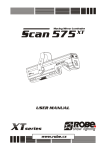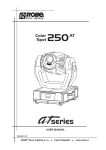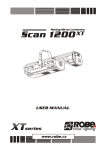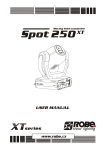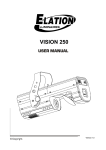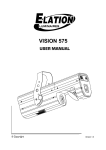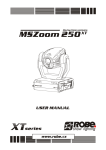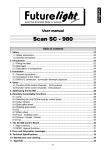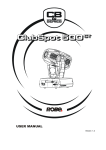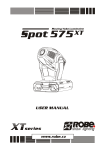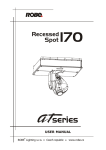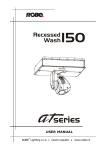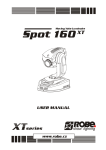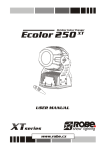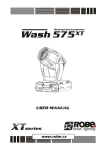Download Untitled
Transcript
1
2
SCAN 250 XT
Table of contents
1. Safety instructions ......................................................................................................... 4
2. Operating determinations ............................................................................................. 5
3. Description of the device .............................................................................................. 6
4. Installation ...................................................................................................................... 7
4.1Fitting the lamp ........................................................................................................... 7
4.2 Installation of an optional lens ................................................................................... 8
4.3 Inserting/Exchanging rotating gobos ......................................................................... 9
4.4 Rigging the fixture ..................................................................................................... 9
4.5 Connection to the mains .......................................................................................... 10
4.6 DMX-512 connection/connection between fixtures ................................................. 10
5. DMX PROTOCOL .......................................................................................................... 11
6.Controller mode ............................................................................................................ 13
6.1DMX addressing ...................................................................................................... 13
6.2Remotely controllable functions ............................................................................... 13
7.Stand - alone mode ...................................................................................................... 14
8. Functions of the control panel .................................................................................... 15
8.1 Addressing .............................................................................................................. 15
8.2 Slave control ........................................................................................................... 16
8.3 Fixture informations ................................................................................................. 16
8.4 Personality options .................................................................................................. 18
8.5 Switching On/Off the lamp ....................................................................................... 22
8.6 Test sequences........................................................................................................ 22
8.7 Stand-alone setting ................................................................................................. 23
8.8 Reset function ......................................................................................................... 24
8.9 Special functions ..................................................................................................... 25
9. Error and information messages ................................................................................ 27
10.Technical specifications ............................................................................................ 28
11. Maintenance and cleaning ........................................................................................ 30
12. Appendix .................................................................................................................... 31
12.1 Changing the power supply settings ..................................................................... 31
3
CAUTION!
Keep this device away from rain and moisture!
Unplug mains lead before opening the housing!
FORYOUR OWN SAFETY, PLEASE READ THIS USER MANUAL CAREFULLY
BEFORE YOU INITIAL START - UP!
1. Safety instructions
Every person involved with installation and maintenance of this device have to:
- be qualilfied
- follow the instructions of this manual
CAUTION!
Be careful with your operations. With a high voltage you can suffer
a dangerous electric shock when touching the wires!
This device has left our premises in absolutely perfect condition. In order to maintain this condition and to ensure
a safe operation, it is absolutely necessary for the user to follow the safety instructions and warning notes written
in this manual.
Important:
The manufacturer will not accept liability for any resulting damages caused by the non-observance of this manual
or any unauthorized modification to the device.
Please consider that damages caused by manual modifications to the device are not subject to warranty.
Never let the power-cord come into contact with other cables! Handle the power-cord and all connections with the
mains with particular caution!
Always plug in the power plug least. The power-plug has to be accessable after installing the device.
Make sure that the power-cord is never crimped or damaged by sharp edges. Check the device and the powercord from time to time.
Always disconnect from the mains, when the device is not in use or before cleaning it. Only handle the power-cord
by the plug. Never pull out the plug by tugging the power-cord.
This device falls under protection class I. Therefore it is essential to connect the yellow/green conductor to earth.
The electric connection, repairs and servicing must be carried out by a qualified employee.
Do not connect this device to a dimmer pack.
Do not switch the fixture on and off in short intervals as this would reduce the lamp’s life.
During the initial start-up some smoke or smell may arise. This is a normal process and does not necessarily
mean that the device is defective.
Do not touch the device’s housing bare hands during its operation (housing becomes hot)!
For replacement use lamps and fuses of same type and rating only.
CAUTION ! EYEDAMAGES !
Avoid looking directly into the light source
(meant especially for epileptics) !
4
2. Operating determinations
This device was designed for indoor use only.
If the device has been exposed to drastic temperature fluctuation (e.g. after transportation), do not switch it on
immediately. The arising condensation water might damage your device. Leave the device switched off until it has
reached room temperature.
When taking the device into operation, please make sure that the housing is closed firmly with all the necessary
screws tightened up.
Never run the device without lamp!
Do not shake the device. Avoid brute force when installing or operating the device.
When choosing the installation-spot, please make sure that the device is not exposed to extreme heat, moisture
or dust. There should not be any cables lying around. You endanger your own and the safety of others!
The minimum distance between light-output and the illuminated surface must be more than 0,8 m.
Make sure that the area below the installation place is blocked when rigging, derigging or servicing the fixture.
Always fix the fixture with an appropriate safety-rope. Fix the safety-rope at the correct holes only.
Only operate the fixture after having checked that the housing is firmly closed and all screws are tightly fastened.
The lamp must never be ignited if the objective-lens or any housing-cover is open, as discharge lamps may
explose and emit a high ultraviolet radiation, which may cause burns.
The maximum ambient temperature ta = 45° C must never be exceeded. Otherwise, the lamp is switched off and
the fixture is out of operation for 5 minutes.
CAUTION!
The lens has to be replaced when it is obviously damaged,
so that its function is impaired, e. g. due to cracks or deep scratches!
Operate the device only after having familiarized with its functions. Do not permit operation by persons not
qualified for operating the device. Most damages are the result of unprofessional operation!
CAUTION!
The lamp has to be replaced when it is damaged
or deformed due to the heat!
Wait at least 15 minutes before remowing the lamp.
Please use the original packaging if the device is to be transported.
Please consider that unauthorized modifications on the device are forbidden due to safety reasons!
If this device will be operated in any way different to the one described in this manual, the product may suffer
damages and the guarantee becomes void. Furthermore, any other operation may lead to dangers like shortcircuit, burns, electric shock, burns due to ultraviolet radiation, lamp explosion, crash etc.
5
3. Description of the device
1 - Fastening screws
2 - Fixation screw for bracket
3 - Bracket
4 - Objective
5 - Mirror
Front panel:
6 - DMX Output
7 - DMX Input
8 - Fuseholder
9 - Powercord
10 - Control board
Control board:
11 - Display
12 - Mode-button
13 - Enter-button
14 - Up-button
15 - Down-button
6
4. Installation
4.1Fitting the lamp
DANGER !
Install the lamps with the device switched off only.
Unplug from mains before !
To insert the lamp (MSD 250 or MSD250/2) open the cover by loosening the fastening screws at the sides of the
cover.
Do not install a lamp with a higher wattage! A lamp like this generates temperatures the device is not designed for.
Damages caused by non-observance are not subject to warranty.
Insert the lamp now. Do not touch the glass bulb with bare hands during the installation! Please follow the lamp
manufacturer‘s notes!
Before you close the cover again, make sure that the lamp is installed tightly into the lampholder system.
Adjust the optimal distance 1-1.5 mm from the lens by turning the screw "A" (see the drawings "Lamp adjustment"
below) on the rear panel of the fixture.
Reclose the housing and tighten the fastening screws.
Before striking the lamp, reset the "LAti" counter in the main menu of the control board, by pressing the "Up" and
"Down" buttons at the same time and then confirming with the "Enter"-button.
Do not operate this fixture with opened housing-cover!
Lamp adjustment:
Correct
Incorrect
optimum distance
1-1,5 mm
Screw"B"
Screw"A"
Keep optimum distance to
the lens
The lampholder is aligned at the factory. Due to differences between lamps, fine adjustment may improve light
performance.
Strike the lamp, cancel all effects, open the shutter and set the dimmer intensity onto 100 % and focus the light
on a flat surface (wall).As the optimum distance of the lamp from lens was adjusted during the installing or
changing the lamp (by turning the screw "A"), it is necessary to adjust only the second position by turning the
screw "B", in order to center the hot-spot (the brightest part of the beam).
If the hot spot seems to be too bright, you can lower its intensity by moving the lamp closer to the reflector. Do so
by turning the srew "A" until the light is evenly distributed.
If the light on the edge seems to be brighter as in the center, the lamp is too close at the reflector. In this case, you
need to move the lamp away from the reflector until the light is evenly distributed and the beam appears bright
enough.
7
4.2 Installation of an optional lens
The device is delivered with a 15°-standard lens. If you wish to insert an optional 12° or 18°-lens (it is not standard
part of delivery,only for request), please follow the instructions below:
Optional 12°-lens:
Remove the the 15°-objective by loosening the 3 fastening screws with an appropriate screwdriver. Fix the tube
with the 3 screws and then screw the flange with 12°-lens .
flange with 12°-lens
tube
15°-objective
Optional 18°-lens:
1.Open the cover by loosening the fastening screws at the sides of the cover.Unscrew the knurled-head screw on
the plate of the light-output. Install the optional 18°-lens module.
2.Fix the 18°-lens module with the knurled-head screw.Close the cover and tighten the fastening screws at the
sides of the cover.
18°- lens holder
knurled-head screw
standard 15°-objective
fastening screws
8
4.3 Inserting/Exchanging rotating gobos
DANGER!
Install the gobos with the device switched off only.
Unplug from mains before!
Open the cover by loosening the fastening screws at the sides of the cover.
If you wish to use other forms and patterns as the standard-gobos, or if the gobos are to be exchanged, remove
the fixation-ring with an appropriate tool. Remove the gobo and insert the new gobo. Press the fixation-ring
together and insert it in the front of the gobo.
CAUTION!
Never unscrew the screws of the rotating gobo
as the ball bearing will otherwise be opened!
4.4 Rigging the fixture
Danger of fire !
When installing the device, make sure there is no highly inflammable
material (decoration articles, etc.) in between a distance of min. 0,5 m.
The SCAN 250 XT can be installed in any position without altering its operation characteristics
Install a safety wire that can hold at least 10 times the weight of the fixture. Never use the carrying handles for
secondary attachment.
Make sure that the device is fixed properly! Ensure that the structure
to which you are attaching the projectors is secure.
For fixing the projectors use the hole provided in the bracket. The hole in the adjustable mounting bracket has a
diameter of 10 mm.
For overhead use, fit a safety chain or cord.
9
4.5 Connection to the mains
Verify the power supply settings before applying power!
If you wish to change the power supply settings,see the chapter Appendix.
Connect the fixture to the mains with the enclosed power cord and plug.
The earth has to be connected!
The occupation of the connection-cables is as follows:
Cable (EU)
Cable (US)
Pin
International
Brown
Black
Live
L
Light blue
White
Neutral
N
Yellow/Green
Green
Earth
4.6 DMX-512 connection/connection between fixtures
Master/slave operation
Controller operation
Only use a stereo shielded cable and 3-pin XLR-plugs and connectors in order to connect the controller with the
fixture or one fixture with another.
Occupation of the XLR-connection:
DMX - output
DMX-input
XLR mounting-socket:
XLR mounting-plug:
1 - Ground
2 - Signal (-)
3 - Signal (+)
1 - Ground
2 - Signal (-)
3 - Signal (+)
If you are using the standard DMX-controllers, you can connect the DMX-output of the controller directly with the
DMX-input of the first fixture in the DMX-chain. If you wish to connect DMX-controllers with other XLR-outputs,
you need to use adapter-cables.
Building a serial DMX-chain:
Connect the DMX-output of the first fixture in the DMX-chain with the DMX-input of the next fixture. Always
connect one output with the input of the next fixture until all fixtures are connected.
Caution: At the last fixture, the DMX-cable has to be terminated with a terminator. Solder a 120 W resistor
between Signal (–) and Signal (+) into a 3-pin XLR-plug and plug it in the DMX-output of the last fixture.
10
5. DMX PROTOCOL
Mode 1 Mode 2 8bit
Value
channel channelchannel
1
2
3
4
1
3
1
Pan
Coarse control of the pan movement
proportional
0-255
Tilt
Coarse control of the tilt movement
proportional
0-255
Pan fine
Fine control of the pan movement
proportional
Tilt fine
Fine control of the tilt movement
proportional
2
2
4
6
7
5
6
7
3
Speed of PAN/TILT movement
0
Max. speed
249
Min. speed
250-255 Max. speed,black-out while PAN,TILT moving
4
8
6
9
9
7
step
proportional
step
0-127
128-139
140-229
230-239
240-255
Lamp on/off,reset,fan speed control
From max.speed of fan to min. speed of fan
Lamp on,reset
No function
Lamp off after 3 sec
No function
proportional
step
step
step
step
0
10
21
32
42
53
64
74
85
96
106
117
128-190
191-192
193-255
Colours
Open/white
Turquoise
Red
Cyan
Green
Magenta
Light blue
Yellow
Green
Pink
Blue
Orange
Forwards rainbow effect from fast to slow
No rotation
Backwards rainbow effect from slow to fast
proportional
proportional
proportional
proportional
proportional
proportional
proportional
proportional
proportional
proportional
proportional
proportional
proportional
step
proportional
5
8
Type of control
0-255
0-255
5
Function
No function
0-95
96-103
104-135
136-143
144-151
152-159
160-255
160-167
168-175
176-183
184-191
192-199
Frost,cor. filters,3-facet prism
Open position (hole)
Frost filter
3-facet prism
3200 K correction filter
5600 K correction filter
UV filter
Prism/gobo macros
Macro 1
Macro 2
Macro 3
Macro 4
Macro 5
11
step
step
step
step
step
step
step
step
step
step
step
Mode 1 Mode 2 8 bit
Value
channel channelchannel
9
10
11
12
9
7
10
8
11
12
Macro 6
Macro 7
Macro 8
Macro 9
Macro 10
Macro 11
Macro 12
step
step
step
step
step
step
step
0
1-126
127-128
129-255
3-facet prism rotation control
No rotation
Forwards rotation from fast to slow
No rotation
Backwards rotation from slow to fast
step
proportional
step
proportional
0-31
32-63
64-95
96-127
128-159
160-191
192-223
224-255
Rotating gobos,cont.rotation
Open
Rot. gobo 1 (dichroic)
Rot. gobo 2 (glass)
Rot. gobo 3 (metal)
Rot. gobo 4 (metal)
Rot.gobo 5 (metal
Rot.gobo 6 (metal)
Rot. gobo wheel cont. rotation from slow to fast
step
step
step
step
step
step
step
proportional
0-127
128-191
192
193-255
Rotating gobo index,rotating gobo rotation
Gobo indexing
Forwards gobo rotation from fast to slow
No rotation
Backwards gobo rotation from slow to fast
proportional
proportional
step
proportional
10
13
11
14
14
12
No function
0-255
15
15
13
0-31
32-63
64-95
96-127
128-159
160-191
192-223
224-255
16
16
Type of control
200-207
208-215
216-223
224-231
232-239
240-247
248-255
9
13
Function
14
0-255
Focus
Proportional focus control
proportional
Shutter,strobe
Shutter closed
No function (shutter open)
Strobe-effect from slow to fast (max.10 flashes/s)
No function (shutter open)
Pulse-effect in sequences
No function (shutter open)
Random strobe-effect from slow to fast
No function (shutter open)
step
step
proportional
step
proportional
step
proportional
step
Dimmer intensity
Gradual adjustment of the dimmer intensity
from 0 to 100%
12
proportional
6.Controller mode
The fixtures are individually addressed (001-497) on a data link and connected to the controller.The fixtures
respond to the DMX signal from the controller.
6.1DMX addressing
The control panel allows you to assign the DMX fixture address, which is defined as the first channel from which
the SCAN 250 XT will respond to the controller.
If you set, for example, the address to channel 5, the SCAN 250 XT will use the channel 5 to 20 for control.
Please, be sure that you don’t have any overlapping channels in order to control each SCAN 250 XT correctly and
independently from any other fixture on the DMX data link.
If two, three or more SCAN 250 XT are addressed similarly, they will work similarly.
For address setting, please refer to the instructions under "Addressing"(menu "A001").
Controlling:
After having addressed all SCAN 250 XT , you may now start operating these via your lighting controller.
Note:After switching on, the SCAN 250 XT will automatically detect whether DMX 512 data is received or not.If
there is no data received at the DMX-input, the display will start to flash "A001" with actually set address.
This situation can occur if:
- the 3 PIN XLR plug (cable with DMX signal from controller) is not connected with the input of the SCAN 250 XT
- the controller is switched off or defective, the cable or connector is defective or the signal wires are swap in the
input connector.
Note:It’s necessary to insert the XLR termination plug (with 120 Ohm) to the last fixture in the link in order to
ensure proper transmission on the DMX data link.
6.2Remotely controllable functions
Lamp
The SCAN 250 XT is to be operated with a MSD/HSD 250 or MSD 250/2 GY-9,5 lamp.
A relay inside of the SCAN 250 XT allows you to switch on and off the lamp via the control panel on the top side
of the base or via your controller without affecting the rest of the lighting.
To switch On/Off the lamp, please refer to "Switching On/Off the lamp " (menu "LAMP").
Note: It is also important to note, that the discharge lamp is cold restrike types, that means, that they have to be
cold before re-striking. For this reason, you have to wait 5 minutes (max. speed of fan must be adjusted) after
having switched Off the lamp before you can switch it back On again. If you try to switch On the lamp within 5
minutes after having switched it Off, the SCAN 250 XT will store this information and automatically ignite the
lamp when the 5 minutes period has expired. The message "HEAt" will appear on the control panel display of the
SCAN 250 XT. If the ignition of the lamp is seven times unsuccessful, on the display will appear "LA.Er.",
meaning that the lamp could be damaged or even missed, or there could be a failure on the ignitor or ballast.
Colour wheel
The SCAN 250 XT has one colour wheel with 12 color positions - 11 of these with dichroic colors and the last one
open. The wheel can be positioned between two adjacent colors in any position. It is also possible to rotate the
color wheel continuously at different speed „Rainbow effect“.
Rotating gobo wheel
1 metal gobo, 4 glass gobos and 1 dichroic gobo rotating in both dirrections, indexable, rotating gobo wheel cont.
rotations from slow to fast.The rotating gobos are interchangeable.
Effect wheel
This wheel has both hot and cold colour temperature filters (3200 K and 5600 K). Total numbers of colour
combinations are 36. Also wash light and UV effect are provided by the special effect wheel.
3-facet rotating prism
3-facet prism rotating in both directions at different speed is situated at the special effect wheel.
13
Focus
Motorized focus enables the beam to be focused anywhere on stage.
Dimmer / Shutter / Strobe
Smooth 0 - 100 % dimming is provided by the combined mechanical dimmer / shutter unit. This unit may also be
used for strobe effect (1 - 10 flashes per second)
Fan
The SCAN 250 XT is cooled by axial fan situated at the rear side of the lighting. The speed of the fan (of course
the noice) can be continuously reduced if very quiet performance is required.
By the control board using the "FAn.S." function you can choose 5 types of fan speed operating modes.
7.Stand - alone mode
The fixtures on a data link are not connected to the controller but can execute pre-set programs which can be
different for every fixture.To set the program to be played,see the "Stand-alone setting" ( menu "St.AL.").
"Stand-alone operation" can be applied to the single fixture (the fixture may be set to the master /slave mode or
controller mode ) or to multiple fixtures operating synchronously.
Synchronous operation of multiple fixtures requires that they must be connected on a data link and one of them
is set as a master (master mode) and the rest as the slaves (slave mode).The slaves are assigned to SLA.1SLA.9 and on the certain slave address can be connected only one fixture.To set the fixture as the master or
slave , see the "Addressing" (menu "A001").
The master fixture starts simultaneous program start in the other slave fixtures.All fixtures have a definite,
synchronized starting point when playing back their programs.The number of running program is the same in all
slaves and depends on the master's choice (menu "St.AL." ).Every fixture runs its program repeatedly ,starting
the program step No.1 when requested by the master .
For example:
If the slave fixture has a shorter program length, it will continously repeat its program until the master fixture
finishes its own program and restarts its program running (slave 1- prog.step 3 will not be finished).
If the slave fixture has a longer program length, it will restart at prog. step 1 before it completes all its prog.steps
(slave 2 - prog.step 5 will not be played)- see the picture bellow.
Restart
Starting point
If the master fixture runs a reset,switches On/Off the lamp or plays test(program) ,all slaves will execute
these acts too (e.g. if the master fixture has switched the lamp off,no slaves can switch the lamp on)!
You can't play or edit any programs on the slaves by their control panels if the master is switched on and
connected to the master/slave chain.
Note:Disconect the fixtures from the DMX controller before master/slave operating ,otherwise data collisions can
occur and the fixtures will not work properly!
It’s necessary to insert the XLR termination plug (with 120 Ohm) into the input of the master fixture and into the
output of the last slave fixture in the link in order to ensure proper transmission on the data link.
From the master's control panel is possible to control any slave in a master/slave chain.
14
8. Functions of the control panel
The control panel situated on the front side of the fixture offers several features. You can simply set the DMX
address,master/slave mode, read the number of lamp or unit hours, switch On and Off the lamp, run test, make
a reset and also use many functions for setting and service purposes.
The main menu of the control panel is accessed by pressing the [Mode] button - press this one so many times
until the display shows message "A001" (with actually stored address). Browse through the menu by the pressing
[Up] or [Down] buttons - the display shows step by step these messages: A001,SLCt, InFO,PErS, LAMP, tESt,
StAL,rESE, SPEC. Press [Enter] if you wish to select one of them. The functions are described in the following
sections and the function hierarchy is shown below.
8.1 Addressing
By this menu you can set the DMX address or address the fixture as a master/slave.
DMX addressing
1. Press the [Mode]- button so many times until the display shows message "A001" (with actually stored address).
2. Press [Enter]-button and use the [Up] and [down] buttons to select"dM.Ad."-menu.
3. Press[Enter]-button(the letter "A" flashes) and by [Up] and [down] buttons select required address (001 497), press [Enter]-button to confirm.
4. Select "M.ASL."-menu,press[Enter]-button and use [Up] and [down] buttons to select "d.AbL."(no master or
slave),press [Enter] to confirm.
5. Press the [Mode]- button.Choosen address is shown on the display.
If message "A001" (with actually stored address) flashes-no DMX data received at the DMX-input.
Master/slave adressing
1. Press the [Mode] button so many times until the display shows message "A001"(with actually stored address).
2. Press [Enter]-button and use the [Up] and [down] buttons to select "MA.SL."-menu.
3. Press[Enter]-button(display flashes) and select"MASt"(to set the fixture as the master in a chain of multiple
fixtures) or "SLA.1"-"SLA.9" (to set the fixture to be the slave in a chain of multiple fixtures) and press [Enter]
to confirm. If you want address no master or slave, select "d.AbL.".
4. Press the [Mode]- button.Choosen address is shown on the display.
If message "MASt." fast flashes-DMX signal is received at the DMX-input- disconnect DMX controller!
15
Only one fixture may be the master. Up to the 9 slaves may be connected to the master and on the certain
address can be connected only one slave fixture (SLA1-SLA9).
Note:Disconect the fixtures from the DMX controller before master/slave operating ,otherwise data collisions can
occur and the fixtures will not work properly!
If the fixture is set as the master and DMX signal is connected to its input,the error massage "MAEr" will appear
on its display and the fixture's address will be set to its DMX address in order to respond to DMX signal from the
controller.
For example:
The master fixture has these address setting:"dM.Ad."-menu.........A017
"MA.SL."-menu........MASt (is displayed)
8.2 Slave control
This function allows you to control the slaves from the master's control panel in a master/slave operation.
Select this function from the main menu and press [Enter]-button.Browse the list of all connected slaves ("SL.C.1"
- "SL.C.9") by pressing [Up] or [Down] button.Select the desired slave and press [Enter]-button.The slave's
control panel is available from the master's control panel.
If no slave is connected to the master,massages "SL.C.1","SL.C.2","SL.C3"..."SL.C.9" still round repeat.
Note:This function is available from the master fixture only.
8.3 Fixture informations
The menu allows you to read an useful information about the fixture as the lamp life,head temperature,software
version, etc.
Press [Up] and [Down] buttons to select the desired option and press [Enter] to see the value or next submenu.
Power On time
-By this option you can read the total number of the operation hours since the
SCAN 250 XT has been fabricated. Press [Enter] or [Mode] to return to the menu.
16
- The number of the hours that the SCAN 250 XT has been powered On since the
counter was last reset.Press [Enter] or [Mode] to return to the menu.In order to reset
this counter to 0, you have to hold the [Up] and [Down]-button and press the [Enter]button.
Lamp On time
- This option enables you to read the total number of the operation hours with the lamp
on since the SCAN 250 XT has been fabricated.Press [Enter] or [Mode] to return
to the menu.
- The number of hours that the lamp has been powered On since the counter was last
reset.Press [Enter] or [Mode] to return to the menu. In order to reset this counter to 0,
you have to hold the [Up] and [Down]-button and press the [Enter]-button.
Lamp strikes
- By this option you can read the total number of the lamp strikes since the SCAN
250 XT has been fabricated.Press [Enter] or [Mode] to return to the menu.
-The number of the lamp strikes since the counter was last reset.Press [Enter] or
[Mode] to return to the menu. In order to reset the counter to 0, you have to hold the
[Up] and [Down]-button and press the [Enter]-button.
Max. fixture head temperature
- By this option you can read the max. temperature of the head inside since the
SCAN 250 XT has been fabricated.Press [Enter] or [Mode] to return to the menu.
- Max. temperature of the head inside since the counter was last reset.Press [Enter] or
[Mode] to return to the menu. In order to reset the counter to 0, you have to hold the
[Up] and [Down]-button and press the [Enter]-button.
Current fixture head temperature
Temperature readouts of the head inside in Celsius. Inside temperatures below 60°C are not critical. 60° C and
more lead to the lamp being switched off. Please note that the outside temperature should not exceed 45° C.
DMX values
Readout DMX values of each channel received by the fixture. Use the [Up] and [Down] buttons to select desired
channel and press [Enter] to read its value coming to the fixture or [Mode] to cancel and return to the menu.
17
Software version
By this function you can read the software version of the display module. Press [Enter] to read its value or
[Mode] to return to the menu.
8.4 Personality options
These options allow you to modify SCAN 250 XT operating behavior.
Press [Up] and [Down] buttons to select the desired option and press [Enter] to set the value or to see next
submenu.
Pan reverse
This function allows you to invert the pan movement. Use the [Up] and [Down] buttons to select "On" if you wish
this feature or "Off" if you don’t wish this feature and press [Enter] to confirm or [Mode] to cancel and return to
the menu.
Tilt reverse
This function allows you to invert the tilt movement. Use the [Up] and [Down] buttons to select "On" if you wish
this feature or "Off" if you don’t wish this feature and press [Enter] to confirm or [Mode] to cancel and return to
the menu.
Movement resolution
By this function you can adjust the 16-bit movement resolution (Mod.1, Mod. 2) or 8-bit resolution (8bit).
Use the [Up] or [Down] keys to select the desired movement resolution and press [Enter] to confirm or [Mode]
to cancel and return to the menu.
List of the channel settings:
18
Channel
1
2
3
4
5
6
7
8
9
10
11
12
13
14
15
16
Mode 1-16bit (default)
Pan
Tilt
Fine Pan
Fine Tilt
Pan/Tilt speed
Fans, On/Off lamp
Colours
No function
Prism
Prism rotation
Rotating gobos
Rot.gobo rotation
No function
Focus
Shutter, strobe
Dimmer
Mode 2-16bit
Pan
Fine Pan
Tilt
Fine Tilt
Pan/Tilt speed
Fans, On/Off lamp
Colours
No function
Prism
Prism rotation
Rotating gobos
Rot.gobo rotation
No function
Focus
Shutter, strobe
Dimmer
8 bit
Pan
Tilt
Pan/Tilt speed
Fans,Lamp On/Off
Colours
No function
Prism
Prism rotation
Rotating gobos
Gobo rotation
No function
Focus
Shutter,Strobe
Dimmer
Please refer to the chapter "DMX- protocol" for detail description.
Note: If you adjust the 16 bit resolution (Mode 1 or Mode 2), the fixture will occupy 16 DMX channels, if you
adjust the 8 bit resolution,the fixture will be operated by only 14 DMX channels.
Lamp presetting
This function allows you to adjust the lamp settings:
Lamp On after switching the fixture On
This function enables to turn the lamp on automatically after switching the fixture on. Use the [Up]
and [Down] buttons to select "On" if you wish to turn the lamp on automatically after switching the
fixture on or "Off" if you wish the lamp off after switching on the fixture and press [Enter] to
confirm or [Mode] to cancel and return to the menu.
Lamp Off via DMX
This function allows you to switch off the lamp by DMX. Use the [Up] and [Down] buttons to select
"On" if you want to switch off the lamp by DMX or "Off" if you don’t want to switch off the lamp by
DMX and press [Enter] to confirm or [Mode] to cancel and return to the menu.
Lamp On if DMX is present
This function allows you to strike the lamp automatically after 26 seconds if DMX signal is present
on the data link.If the ignition is unsuccessfull (e.g.lamp is too hot),the fixture will try to ignite the
lamp after next 26 s.This process will repeat until the lamp lights.Use the [Up] and [Down] buttons
to select "On" if you want to strike the lamp or "Off" if you don’t want to strike the lamp and press
[Enter] to confirm or [Mode] to cancel and return to the menu.
19
Lamp Off if DMX is missing
This function allows you to switch Off the lamp automatically after 2 minutes if DMX signal is
missing on the data link. Use the [Up] and [Down] buttons to select "On" if you want to switch Off
the lamp or "Off" if you don’t want to switch Off the lamp and press [Enter] to confirm or [Mode]
to cancel and return to the menu.
Switch On/Off the lamp light sensor
Use the [Up] and [Down] buttons to select "On" if you wish to switch the lamp light sensor on and press [Enter]
to confirm or [Mode] to cancel and return to the menu.The option"On" is for the standard operation.Use the
[Up] and [Down] buttons to select "Off" if you wish to switch the lamp light sensor Off and press [Enter] to
confirm or [Mode] to cancel and return to the menu.
Important: The option"Off" is for "emergency operation" only if the lamp light sensor is defective and
you will wait for a service intervertion! If the lamp light sensor is switched Off,the error messages
"LAEr,SnEr,HEAt" will not appear on the display (only the message "HEAt" will appear if the lamp was turned off
and on within 5 minutes ) and at switching the lamp on the electronics will still try to ignite the lamp until it shines
(even when the lamp is damaged or absent), on this account some electronics parts could be damaged!
Display adjusting
This function allows you to adjust the display settings:
Display intensity
With this function you can adjust the display-intensity from 20% to 100% . Use the [Up] and [Down]
buttons to select the level of the display- intensity and press [Enter] to confirm or [Mode] to cancel
and return to the menu.
Display-reverse
With this function, you can rotate the display by 180°. Use the [Up] and [Down] buttons to select
"normal display" or "display turned by 180°" and press [Enter] to confirm or [Mode] to cancel and
return to the menu.
Display-On
This function allows you to keep the display on or to turn off automatically 2 minutes after last
pressing any button on the control panel. Use the [Up] and [Down] buttons to select "On" if you
wish to keep the display on or "Off" if you wish to turn off automatically 2 minutes after last pressing
any button on the control panel and press [Enter] to confirm or [Mode] to cancel and return to the
menu.
20
Fan speed operating modes
By using this function you can choose 5 types of the fan speed operating modes. Browse through this menu by
the pressing [Up] and [Down] buttons - the display shows step by step these messages: "Auto,HIGH, reG,
LoOF, LoHI". Press [Enter] if you wish to select one of them or [Mode] to cancel and return to the menu.
Continuous controlling of the fan speed without the DMX value
The fan automatically raises its speed in order to control inside temperature of the lighting, if the
temperature inside increases about certain level (the low fan speed reduces the cooling of the
lighting). This cycle can repeat several times until the temperature inside is on suitable level.The
initial level of the fan speed can´t be adjusted by the DMX.
High (max.) speed of fans
The cooling fan works on max. speed (max. cooling)
Continuous controlling of the fan speed
This mode is similar to "Auto", but the initial level of the fan speed can be adjusted by the DMX.
Low speed/Switch Off the lamp operating
The fan keeps the adjusted low speed until the temperature exceeds max. inside temperature of the
fixture, then the SCAN 250 XT automatically switches off the lamp.
Low/high speed of the fan operating
The fan keeps the adjusted low speed until the temperature exceeds max. inside temperature of the
fixture, then the SCAN 250 XT automatically switches from low to high the fan speed.
Note:The modes "Auto" and "HIGH" don´t interact to the DMX value on the channel 6 (0-127)!
21
Default settings
Press [Enter] to reset all fixture personalities (not the adjusting functions) to the default values. On the display
will appear "rSt" meaning that the fixture makes the reset. See the table of personality setting and their default
positions.
Personality
Display
Default values
(SHADED)
Pan reverse
Tilt reverse
Movement resolution
Lamp On after switch.
the fixture On
Lamp Off via DMX
Lamp On if DMX
is present
Lamp Off if DMX
is missing
Display-On
Display intensity
Display- reverse
Switch On/Off
the lamp light sensor
Fan speed operating
modes
8.5 Switching On/Off the lamp
Press the [Mode] button in order to access the main menu. Browse through the menu by pressing the [Up] and
[Down] buttons until the display shows "LAMP". Confirm by pressing [Enter] button.
Use the [Up] and [Down] buttons to select "On" to switch On the lamp and "Off" to switch Off the lamp and
press [Enter] to confirm or [Mode] to cancel.
8.6 Test sequences
This function allows you to run a special demo-test sequences without an external controller, which will show you
some possibilities of using the SCAN 250 XT. Press [Up] and [Down] keys to select the "Mod1" or "Mod2"
22
sequences. The "Mod1" is suitable for projections on the wall, ceiling or ground without any mirror-movement, the
"Mod2" uses all SCAN 250 XT functions and therefore is good for a complete introduction of the fixture.Select
"Mod1" or "Mod2" by [Up] and [Down] buttons and press [Enter] to confirm the choice.If the test program is
running,messages "run/test" blink on the display.
If you want to pause the runnnig program in the required position, press the [Enter]-button(messages"PAUS"/"
test" blink ).To continue the program running,press the [Enter]-button again.
8.7 Stand-alone setting
This menu offers options for stand-alone mode as a selection of the playing program,programming and modifying
current programs.
Presetting playback
This function allows you to select the the program which will be played in the stand-alone mode after switching
the fixture On.Use the [Up] and [Down] buttons to select desired program ("tESt"- bilt-in program) or "OFF" if you
don't want trigger any program after switching the fixture On and press [Enter] to confirm or [Mode] to cancel and
return to the menu.Selected program will be played continuously in a loop as long as it appears on the display.
This option should be set "OFF" for all slaves in the master/slave chain by reason of the right program starts.
For example: You have selected program "PrG.3" in this menu and:
this fixture is set as a single fixture (master/slave or controller operating)- the fixture will run its program "PrG.3".
this fixture is set as a master in a data chain- the fixture will run its program "PrG.3".
this fixture is set as a slave in a data chain- the fixture will run its program according to the master(if the master
runs its own program "PrG.1", the slave will run its own program "PrG.1"also).
Note:If the fixture operates in the controller mode ( DMX controller is connected) and any program from this menu
is selected ,in this case the fixture will not respond to the DMX controller after switching On and will play selected
program.
23
Playing program
This function allows you to run a bilt-in program "tESt" and the 3 freely-programmable programs
"PrG.1,PrG.2,PrG.3" .Press [Up] or [Down] buttons to select the desired program and press [Enter] to run the
program which will be played continuously in a loop.
If you want to pause the runnnig program in the required position, press the [Enter]-button(messages"PAUS"/"
program No."blink ).To continue the program running,press the [Enter]-button again.
Note:If the fixture operates in the controller mode ( DMX controller is connected) and any program from this
function is selected in this case the fixture will not respond to the DMX controller and will play selected program.
You can't play programs on the slave fixtures from their control panels if the master fixture is switched On and
connected to the slaves (playing is forced by the master).
Editing program
This menu item allows you to select a program to edit or create.The SCAN 250 XT has one built-in program
("tESt") and the 3 free programs,each up to 99 steps.
If the fixture is set as a master ,then you may edit any program in the slaves.You can't edit programs on the slave
fixtures from their control panels if the master fixture is switched on and connected to the slaves (editing is
possible by the master control panel only).
Procedure:
1. Press [Up] or [Down]-button to select the program you want to edit ("PrG.1" - "PrG.3") and press [Enter].
2. Press [Up] or [Down]-button to select the desired fixture ("MASt." - "SLA.9") and press [Enter]-button.
3. Press [Up] or [Down]-button to select the desired program step ("St.01" - "St.99") and press [Enter]-button.
4 Press [Up] or [Down]-button to select the desired item and press [Enter]-button.Now you can edit by [Up] or
[Down] buttons the DMX value for selected item:
"P.End." - a total number of the program steps,value 1-99 .This value you must set before start
programming(e.g. if you want to create program with the 10 steps,set the value onto 10).
"PAn" a pan,value 0-255
"tilt" a tilt,value 0-255
"F.PAn" - a fine pan, value 0-255
"F.tilt" a fine tilt,value 0-255
"SPEd" - a speed of PAN/TILT movement,value 0-255
"Colo." - a colour wheel , value 0-255
"EFFE." - a frost,cor.filters,3-facet prism,value 0-255
"P.rot" a prism rotation,value 0-255
"r.Gob." - a rot.gobo,value 0-255
"G.rot." - a rot. gobo rotation,value 0-255
"Foc." a focus ,value 0-255
"Stro." a strobe,value 0-255
"dimr" a dimmer, value 0-255
"S.tim." - a step time,value 0,1-25,5 seconds
"COPY." - a copying the current prog. step to the next prog. step .If the last prog.step is copied to the
next prog. step ,parameter "P.End" is increased about 1 by itself (except step 99).
5. Press Enter]-button to confirm adjusted value .
6. Press [Mode]-button,select next prog. step and repeat this procedure (steps 4 and 6).
The editting programs "PrG.1,PrG.2,PrG.3" are saved in the current modified fixture (master or slave1-9).
8.8 Reset function
Press [Enter] button to run a reset. This option enables the SCAN 250 XT to index all effects (functions) and
return to their standard positions.
24
8.9 Special functions
Use the [Up] and [Down] buttons to browse through the special functions and select the one by pressing [Enter].
Manual control of effects
The function allows you to control manually the channel functions of the fixture. Use the [Up] and [ D o w n ]
buttons to select desired function and press [Enter] to adjust the effect or [Mode] to cancel and return to the
menu.
Lamp adjustment
This function can be used when you make the fine adjustment of the lamp.If you select "LAAd" pressing by
[Enter]-button ,all effects will be canceled,shutter will be opened and the dimmer intensity will be set onto 100%.By
using the options "PAn, tilt,Foc" you can focus the light on a flat surface (wall) and perform the fine lamp
adjustment.
Fixture code
The option contains identification code (1-9999) for the fixture, which is used for the master/slave operation.
25
Adjusting the default positions of colour, gobo and effect wheels
By this function you can calibrate and adjust the colour and gobos to their standard/right positions. Use the [Up]
and [Down] keys to browse through the adjusting menu - the display shows step by step these messages: " PAn,
Tilt,FPAn,FtiLt, SPEd,Func,Colo, EFEC, Prot,rGob, rotG, Foc, Stro, dimr, FCAL" by which you can adjust the
fixture to the required/desired position (0-255) before the function calibration. Then when the positioning is finished
use the last "FCAL" function (Fixture calibration).
1. Calibration via the control board
Press [Enter] and the [Up] and [Down] keys in order to display the following messages: "Colo, EFEC, rGob,
rotG," for very smooth function calibration. Select one of them, press [Enter] and use the [Up] and [Down] keys
in order to adjust their right value from 0 to 255. Then press [Enter] to confirm or [Menu] to cancel and return to
the menu. This can be repeated for each calibration parameter if it is required. When the calibration is finished, it
is necessary to use the "ArES" function in order to write the calibration values to the memory (EPROM) and to
make a reset in order to check the newly adjusted positions of the colour, gobo and effect wheels. When the reset
of the fixture is finished, the display will show the "FCAL" message. Press [Enter] to repeat the calibration or
[Menu] to return to the "AdJ" menu.
2. Calibration via the external controller
Press [Enter] and the [Up] and [Down] keys in order to display the following messages: "Colo,EFEC, rGob,
rotG," - calibration parameters. Select one of them and press [Enter].
Now you can calibrate the the colour, gobo and effect wheel by your controller. The DMX calibration protocol is
described in the table.
DMX Calibration protocol:
26
After having calibrated required functions press [Enter] to confirm (or [Menu] to cancel and return to the menu
without reset by the "ArES" function) and use the "ArES" function in order to write the calibration values to the
memory (EEPROM) and to make a reset in order to check the new adjusted positions of the colour,effect and
gobo wheels .
9. Error and information messages
HEAt
This message appears if you try to switch on the lamp within 5 minutes after having switched it off (the lamp is too
hot). The message will appear on the display if the lamp doesn't ignite within 28 seconds. The SCAN 250 XT will
store this information and automatically ignite the lamp when the 5 minutes period has expired.
Caution: The message is disabled if the lamp light sensor (function "En.Sn.") is switched Off (only if the lamp
was turned Off and On within 5 minutes,the message "HEAt" will appear).
LA.Er.
The ignition of the lamp is seven times unsuccessful (the "HEAt" message appeared six times before), and the
display shows "LA.Er", meaning that the lamp could be damaged or even missed, the fixture is overheating (this
can occur if the ambient temperature is 45° C or more) or there could be a failure on the ignitor or ballast.
Please place or replace the lamp, check the ambient temperature or contact your dealer if the situation was not
caused by the lamp.
Caution: The message is disabled if the lamp light sensor (function "En.Sn.") is switched Off.
FAn
The message informs you that the fixture was overheating and switched off. This message will appear on
the display if the fan speed operating "LOOF" was selected.
MbEr
This messsage informs you that the main PCB does not communicate correctly with the Control Board.
CoEr (color-wheel error)
This messsage will appear after the reset of the fixture if the magnetic-indexing circuit malfunctions (sensor
failed or magnet missing) or the stepping-motor is defective (or its driver circuit on the main PCB). The color-wheel
is not located in the default position after the reset.
rGEr (rotating gobo wheel error)
This messsage will appear after the reset of the fixture if the magnetic-indexing circuit malfunctions
(sensor failed or magnet missing) or the stepper motor is failed (or its driver circuit on the main PCB). The rotating
gobo wheel is not after the reset in the default position.
IGEr (rotating gobo indexing error)
This messsage will appear after the reset of the fixture if the magnetic-indexing circuit malfunctions
(sensor failed or magnet missing) or the stepper motor is failed (or its driver circuit on the main PCB). The rotating
gobo is not after the reset in the default position.
EFEr (effect wheel error)
This messsage will appear after the reset of the fixture if the magnetic-indexing circuit malfunctions
(sensor failed or magnet missing) or the stepper motor is failed (or its driver circuit on the main PCB). The effect
wheel is not after the reset in the default position.
FtEr
This error message informs you that the fixture was overheating (occured if the ambient temperature is 45°
C or more) and that the relay switched off the lamp. This message will appear on the display until the temperature
will be on a suitable level, then the display will show the "HEAt" message meaning the lamp is too hot (explanation
see above).
MAEr
The message informs you that the fixture was addressed as a master and DMX signal is connected to its
input.Disconnect the DMX controller from fixture's input and address the fixture as the master again.The message
appears after switching the fixture Off and On.
SnEr
This message appears if the lamp lighting sensor is failed.
27
Caution: The message is disabled if the lamp light sensor (function "En.Sn.") is switched Off.
PoEr
This message will appear if the fixture was shortly disconnect from the main.
FrEr
It will appear if the frequency of the main is not standard 50 or 60Hz.
10. Technical specifications
Power supply:
EU version -Voltage...........................208/230/240V AC, 50/60 Hz ~
-Fuse...............................T 3.15 A@ 230 V
US version -Voltage...........................100/120/208/230/240V AC, 50/60 Hz ~
-Fuse...............................T 6.3 A@120V
-Power consumption..........500VA
Motors:
-9 high quality stepping-motors controlled by microprocessors
Lamps:
-Philips MSD 250 or MSD250/2 GY9.5
Optical system:
-Double condensor lens with high efficiency parabolic mirror
-Standard 15° objective
-Optional narrow 12° objective or wide 18° objective
Colours:
- 11 dichroic-filters plus white
- Colour-wheel with variable rotation speed
Rotating gobos:
- 4 metal gobo, 1 glass gobos and 1 dichroic gobo rotating in both dirrections at different speeds
- gobo indexing
- rotating gobo wheel cont. rotation
-Metal gobos:outside diameter=26.9mm,image diameter=22.5mm,stainless steel,thickness=0.15mm
-Multicolor dichroic gobo:outside diameter=26.8mm,thickness=1.1mm,high temperature borofloat
or better glass
-Glass gobo:outside diameter=26.8mm,max.thickness=4mm,high temperature borofloat or better
glass
-3 additional metal gobos and 2 glass gobos are included
Strobe:
- Strobe effect with variable speed (1 - 10 flashes per second)
Dimmer:
-Smooth dimmer from 0 - 100 %
Effects:
- Special effect wheel with frost filter, color temperature filters 3200 K and 5600 K, UV filter
Prisma:
- 3 facet prism rotating in both dirrections at different speeds situated on effect wheel
Focus:
-Motorized focus from near to far
28
Beampath:
Electronics:
-Addressing, special functions setting, effects calibration via control panel with 4-digit LED display
-Readout fixture and lamp usage, receiving DMX values, temperature, etc
-Built-in analyzer for easy fault finding,error messages
-Bilt-in demo sequences
-Master-slave operation
-Silent fans cooling, remotely controllable speed of fans
-Self-resetable thermo-fuse
-Digital serial input DMX-512
-DMX-control via every standard DMX controller
-14 DMX-channels (8 bit Pan/Tilt movement resolution)
-16 DMX-channels (16 bit Pan/Tilt movement resolution):
Channel
1
2
3
4
5
6
7
8
9
10
11
12
13
14
15
16
Mode 1-16bit (default)
Pan
Tilt
Fine Pan
Fine Tilt
Pan/Tilt speed
Fans, On/Off lamp
Colours
No function
Prism
Prism rotation
Rotating gobos
Rot.gobo rotation
No function
Focus
Shutter, strobe
Dimmer
Mode 2-16bit
Pan
Fine Pan
Tilt
Fine Tilt
Pan/Tilt speed
Fans, On/Off lamp
Colours
No function
Prism
Prism rotation
Rotating gobos
Rot.gobo rotation
No function
Focus
Shutter, strobe
Dimmer
29
8 bit
Pan
Tilt
Pan/Tilt speed
Fans,Lamp On/Off
Colours
No function
Prism
Prism rotation
Rotating gobos
Gobo rotation
No function
Focus
Shutter,Strobe
Dimmer
Temperatures:
-Maximum ambient temperature ta: 45° C
-Maximum housing temperature tB (steady state): 95° C
Minimum distances:
-Min.distance from flammable surfaces: 0,5m
-Min.distance to lighted object: 0,8m
Housing
- Easy access to lamp and main components thanks to large opening cover and the projector‘s
modular construction.
Dimensions (mm):
Weight:
16 kg
Accessories
- Accessories gobo-set 1.................................15050010
Optional accessories:
Objective12° SCN.................................99010184
Lens-module 18°...................................99010200
11. Maintenance and cleaning
It is absolutely essential that the fixture is kept clean and that dust, dirt and smoke-fluid residues must not build
up on or within the fixture. Otherwise, the fixture‘s light-output will be significantly reduced. Regular cleaning will
not only ensure the maximum light-output, but will also allow the fixture to function reliably throughout its life.
A soft lint-free cloth moistened with any good glass cleaning fluid is recommended, under no circumstances
should alcohol or solvents be used!
DANGER !
Disconnect from the mains before starting any
maintenance work
The front mirror and objective lens will require weekly cleaning as smoke-fluid tends to building up residues,
reducing the light-output very quickly. The cooling-fan should be cleaned monthly.
The gobos may be cleaned with a soft brush. The interior of the projector should be cleaned at least annually using
a vacuum-cleaner or an air-jet.
The dichroic colour-filters, the gobo-wheel and the internal lenses should be cleaned monthly.
To ensure a proper function of the gobo-wheel, we recommend lubrication in six month intervals. The quantity of
oil must not be excessive in order to avoid that oil runs out when the gobo-wheel rotates.
Version 1.1
30
12. Appendix
12.1 Changing the power supply settings
Both the transformer and the ballast must be connected correctly for the local AC voltage and frequency.
The wrong settings can cause poor performance or demage of the moving head.The factory settings are printed
next to the power cord.
If you want to change the power supply settings,follow the instructions:
1.Disconnect the fixture from AC power.
2.Remove the fixture cover by loosening the 4 screws.
3.Move the wire 1 on the transformer connection block to the position according to the desired voltage.
4.Move the wires 2 and 3 on the ballast connection block to the position according to the desired frequency
(voltage).
5.Put the cover back before applying AC power.
Examples:
EU-version
US-version
31































